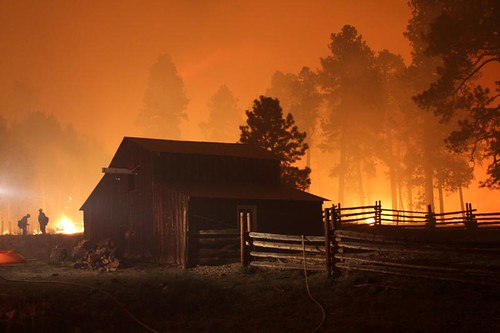
Those of us living and working in the Southwestern U.S. have recently experienced a prolonged, extreme drought persisting over several years. We have witnessed large, destructive and catastrophic wildfires that have taken both lives and property, observed expansive areas of forest tree death as a result of massive insect outbreaks, and seen our water supplies in reservoirs and dams across the region decline to previously unseen levels. Yet, what can we realistically do in the face of these climatically driven changes that will likely continue and intensify into the future?
Changing climatic conditions in the southwest that impact temperatures, alter growing seasons, increase plant moisture stress, and trigger extreme events directly contribute to these recent regional catastrophes and water scarcities. Recently, a highly respected, third generation public land cattle rancher in our region put it this way: “I believe that the climate is changing. But I can’t accept it. If I do I would just go out of business. I have to cope and go on.” So we are left to look around us and ask what information, tools, and technology can we reach for when it gets tough?
USDA’s answer is to build a climate and weather “toolshed” in each region of the country, specifically tailored to that region’s production needs and climate and weather issues. These toolsheds are known as USDA Regional Climate Hubs. The primary purpose we envision for the Southwestern Regional Climate Hub (SWRCH) is to provide information and technical assistance to help the people working and living in the southwest to cope in the face of an uncertain and changing climate and more variable weather.
When I think of the task ahead of us I am reminded of a well-known story from the early days of NASA. Scientists and engineers were working to design and construct the first space capsule, but there was no known material that could absorb the 3000F temperatures experienced when reentering the earth’s atmosphere. They couldn’t change the heat caused by friction of an object moving through this atmosphere, so they adapted. They found innovative strategies, including covering the capsule in tiles that would reflect the heat, rather than try to simply absorb it. They found ways to cope. The challenges of adapting production to a changing climate and shifting weather patterns will require this same spirit of ingenuity and out-of-the box thinking.
Our task with the SWRCH is to help identify, communicate and implement agricultural and land management practices that can help us “reflect” the current and future impacts of our changing climate. For example, over the last several years the U.S. Forest Service, Natural Resources Conservation Service and Agricultural Research Service, working with farmers and New Mexico State University, expanded and improved water monitoring instrumentation throughout the upper Rio Grande watershed in northern New Mexico. The Rio Grande supplies 56 percent of the water used for irrigation agriculture throughout the state, and water supplies have become increasingly limited. This new network of instruments now supplies real-time data that are used to greatly improve forecasts of water supplies for irrigation. This information can be used to better plan crop management given realistic water supply projections. Our Hub will continue looking for new ways to gather data and build tools like this one to support producers as they make the decisions that keep our nation supplied with food, fuel, and fiber.
The SWRCH will work to provide high quality and timely information and resources to cope with the realities of the changing climate and variable weather that our communities are already feeling. Though based in Las Cruces, New Mexico, we are reaching out to the whole Southwest through our partners and collaborators and look forward to hearing from our stakeholders near and far. We look forward to working with and for you.
